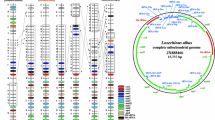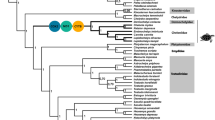Summary
Sea urchin and rodent genomes have been posited to evolve rapidly as indicated by divergences in single copy nuclear DNA sequences. We have examined whether the synonymous substitution rates of three highly conserved genes, β-tubulin, histone H4, and histone H3, adhere to these high genomic substitution rates by comparing sequences between two sea urchins,Strongylocentrotus purpuratus andLytechinus pictus, and between rodents and humans. Whereas the rate of change between the 3′ untranslated regions of the β-tubulin cDNA ofS. purpuratus (Sp-β1), sequenced in this study, and ofL. pictus (Lp-β3) was consistent with the overall rate of change estimated from previous DNA hybridization results between these species, the synonymous substitution rates for the carboxyl domains of these β-tubulins, as well as for the late histones H4 and H3, were significantly depressed. In contrast, synonymous nucleotide substitution rates between rodents and between rodent and human for the carboxyl domain proper of identical β-tubulin isotypes and for histone H4 and H3.1 did not differ from the overall rate of change for the rodent genomes. Moreover, an analysis of paralogous human and mouse β-tubulin sequences supported the conclusion that the synonymous substitution rates in the mouse were higher than those in the human. Differences in constraint on evolutionary change were not evident strictly from the conserved amino acid sequences and base compositions of these genes. Other constraining influences seemed more relevant to the departure of the synonymous substitution rates of the sea urchin β-tubulin and histone coding regions from the average genomic rate.
Similar content being viewed by others
References
Alexandraki D, Ruderman JV (1981) Sequence heterogeneity, multiplicity, and genomic organization of α- and β-tubulin genes in sea urchins. Mol Cell Biol 1:1125–1137
Alexandraki D, Ruderman JV (1983) Evolution of α- and β-tubulin genes as inferred by nucleotide sequences of sea urchin cDNA clones. J Mol Evol 19:397–410
Alexandraki D, Ruderman JV (1985) The expression of α- and β-tubulin genes during development of sea urchin embryos. Dev Biol 109:436–451
Alonso S, Minty A, Bourlet Y, Buckingham M (1986) Comparison of three action-coding sequences in the mouse; evolutionary relationships between the actin genes of warmblooded vertebrates. J Mol Evol 23:11–22
Bennetzen JL, Hall BD (1982) Codon selection in yeast. J Biol Chem 257:3026–3031
Bernard MP, Chu M, Myers JC, Ramirez F, Eikenberry EF, Prickop DJ (1983) Nucleotide sequences of complementary deoxyribonucleic acid for the proα1 chain of human type I procollagen. Biochemistry 22:5213–5223
Bernardi G, Bernardi G (1986) Compositional constraints and genome evolution. J Mol Evol 24:1–11
Bernardi G, Olofson B, Filipski J, Zerial M, Salinas J, Cuny G, Meunier-Rotival M, Rodier F (1985) The mosaic genome of warm-blooded vertebrates. Science 238:953–958
Britten RJ (1986) Rates of DNA sequence evolution differ between taxonomic groups. Science 231:1393–1398
Britten RJ, Graham DE, Neufeld BR (1974) Analysis of repeating DNA sequences by reassociation. Methods Enzymol 29:363–406
Busslinger M, Rusconi S, Birnstiel ML (1982) An usual evolutionary behavior of a sea urchin histone gene cluster. EMBO J 1:27–33
Childs G, Nocente-McGrath C, Lieber T, Holt C, Knowles JA (1982) Sea urchin (Lytechinus pictus) late stage histone H3 and H4 genes: characterization and mapping of a clustered but nontandemly linked gene family. Cell 31:383–393
Cleveland DW, Sullivan KF (1985) Molecular biology and genetics of tubulin. Annu Rev Biochem 54:331–365
Devereux J, Haeberli P, Smithies O (1984) A comprehensive set of sequence analysis programs for the VAX. Nucleic Acids Res 12:387–395
Floyd EE, Gong Z, Brandhorst BP, Klein WH (1986) Calmodulin gene expression during sea urchin development: persistence of prevalent maternal protein. Dev Biol 113:501–511
Galau GA, Britten RJ, Davidson EH (1974) A measurement of sequence complexity of polysomal messenger RNA in sea urchin embryos. Cell 2:9–20
Ginzberg I, Teichman A, Dodemont HJ, Behar L, Littauer UZ (1985) Regulation of three β-tubulin mRNAs during rat brain development. EMBO J 4:3667–3673
Gunning P, Mohun T, Ng SY, Ponte P, Kedes L (1984) Evolution of the human sarcomeric-actin genes: evidence for units of selection within the 3′ untranslated regions of the mRNAs. J Mol Evol 20:202–214
Hall TJ, Grula JW, Davidson EH, Britten RJ (1980) Evolution of sea urchin nonrepetitive DNA. J Mol Evol 16:95–110
Hardin PE, Klein WH (1987) Unusual sequence conservation in the 5′ and 3′ untranslated regions of the sea urchin spec mRNAs. J Mol Evol 25:126–133
Harlow P, Nemer M (1987a) Developmental and tissue-specific regulation of β-tubulin gene expression in the embryo of the sea urchinStrongylocentrotus purpuratus. Genes and Development 1:147–160
Harlow P, Nemer M (1987b) Coordinate and selective β-tubulin gene expression associated with cilium formation in sea urchin embryos. Genes Dev (in press)
Hentschel CC, Birnstiel ML (1981) The organization and expression of histone gene families. Cell 25:301–313
Hinegardener RT (1967) Echinoderms. In: Wilt FH, Wessels NK (eds) Methods in developmental biology. Crowell, New York, p 139
Ikemura T, Ozeki T (1982) Codon usage and transfer RNA contents: organism-specific codon-choice patterns in reference to isoacceptor contents. Cold Spring Harbor Symp Quant Biol 47:1087–1097
Kaumeyer JF, Weinberg ES (1986) Sequence, organization and expression in adult tissues of the sea urchinsStrongylocentrotus purpuratus andLytechinus pictus: tissue specific expression of sperm histone genes. Mol Cell Biol 6:2602–2612
Kirchner K, Mandelkow EM (1985) Tubulin domains responsible for assembly of dimers and protofilaments. EMBO J 4:2397–2402
Krauhs E, Little M, Kempf T, Hofer-Warbinek R, Ade W, Ponstingl H (1981) Complete amino acid sequence of β-tubulin from porcine brain. Proc Natl Acad Sci USA 78:4156–4160
Lewis SA, Lee MG, Cowan NJ (1985) Five mouse tubulin isotypes and their regulated expression during development. J Cell Biol 101:852–861
Li WH, Tanimura M (1987) The molecular clock runs more slowly in man than in apes and monkeys. Nature 326:93–96
Li WH, Wu CI, Luo CC (1985) A new method for estimating synonymous and nonsynonymous rates of nucleotide substitution considering the relative likelihood of nucleotide and codon changes. Mol Biol Evol 2:150–174
Mandelkow EM, Herrmann M, Ruhl U (1985) Tubulin domains probed by limited proteolysis and subunit specific antibodies. J Mol Biol 185:311–327
Maxson R, Mohun T, Gormezana G, Childs G, Kedes LH (1983) Distinct organizations and patterns of expression of early and late histone gene sets in the sea urchin. Nature 301:120–125
Needleman SB, Wunsch CD (1970) A general method applicable to search for similarities in the amino acid sequence of two proteins. J Mol Biol 48:443–453
Perler F, Efstratiadis A, Lomedico P, Gilbert W, Kolodner R, Dodgson J (1980) The evolution of genes: the chicken preproinsulin gene Cell 20:555–566
Powell JR, Caccone A, Amato GD, Yoon C (1986) Rates of nucleotide substitution inDrosophila mitochondrial DNA and nuclear DNA are similar. Proc Natl Acad Sci USA 83:9090–9093
Raff RA (1987) Constraint, flexibility, and phylogenetic history in the evolution of direct development in sea urchins. Dev Biol 119:6–19
Raff RA, Anstrom JA, Huffman CJ, Leaf CJ, Loo JH, Showman RM, Wells DE (1984) The origin of a gene regulatory mechanism in the evolution of echinoderms. Nature 310:312–314
Roberts JW, Johnson SA, Kier P, Hall TJ, Davidson EH, Britten RJ (1985) Evolutionary conservation of DNA sequences expressed in sea urchin eggs and early embryos. J Mol Evol 22:99–107
Roberts SB, Weisser KE, Childs G (1984) Sequence comparisons of non-allelic late histone genes and their early stage counterparts. J Mol Biol 174:647–662
Sackett DL, Wolff J (1986) Protoeolysis of tubulin and the substructure of the tubulin dimer. J Biol Chem 261:9070–9076
Seiler-Tuyns A, Birnstiel ML (1981) Structure and expression in L-cells of a cloned H4 histone gene of the mouse. J Mol Biol 151:607–625
Sharp PM, Li WH (1986) An evolutionary perspective on synonymous codon usage in unicellular organisms. J Mol Evol 24:28–38
Shepherd GW, Rondinelli E, Nemer M (1983) Differences in abundances of individual mRNAs in normal and animalized sea urchin embryos. Dev Biol 96:520–528
Smith AB (1984) Echinoid paleobiology. Allen and Unwin, London
Sullivan KF, Cleveland DW (1986) Identification of conserved isotype-defining variable sequences for four vertebrate β-tubulin polypeptide classes. Proc Natl Acad Sci USA 83:4327–4331
Taylor JD, Wellman SE, Marzluff WF (1986) Sequences of four mouse histone H3 genes: implications for evolution of mouse histone genes. J Mol Evol 23:242–249
Theurkauf WF, Baum H, Jieying B, Wensink PC (1986) Tissue specific and constitutive α-tubulin genes ofDrosophila melanogaster code for structurally distinct proteins. Proc Natl Acad Sci USA 83:8477–8481
Valenzuela P, Quiroga M, Zaldivar J, Rutter WJ, Kirshner MW, Cleveland DW (1981) Nucleotide and corresponding amino acid sequences encoded by α- and β-tubulin mRNAs. Nature 289:650–655
Vawter L, Brown WM (1986) Nuclear and mitochondrial DNA comparisons reveal extreme variation in the molecular clock. Science 234:194–196
Vieira J, Messing J (1982) The pUC plasmids, an M13mp7-derived system for insertion mutagenesis and sequencing with synthetic universal primers. Gene 19:259–268
Wang D, Villasante A, Lewis SA, Cowan NJ (1986) The mammalian β-tubulin repertoire: hematopietic expression of a novel, heterologous β-tubulin isotype. J Cell Biol 103:1903–1910
Wells D, Bains W, Kedes L (1986) Codon usage in histone gene families of higher eukaryotes reflects functional rather than phylogenetic relationships. J Mol Evol 23:224–241
Wu CI, Li WH (1985) Evidence for higher rates of nucleotide substitution in rodents than in man. Proc Natl Acad Sci USA 82:1741–1745
Yaffe D, Nudei U, Mayer Y, Neuman S (1985) Highly conserved sequences in the 3′ untranslated region of mRNAs coding for homologous proteins in distantly related species. Nucleic Acids Res 13:3723–3737
Yanish-Perron C, Vieira J, Messing J (1985) Improved M13 cloning vectors and host strains: nucleotide sequences of the M13mp18 and pUC 19 vectors. Gene 33:103–119
Zhong R, Roeder RG, Heintz N (1983) Primary structure and expression of four cloned human histone genes. Nucleic Acids Res 11:7409–7425
Author information
Authors and Affiliations
Rights and permissions
About this article
Cite this article
Harlow, P., Litwin, S. & Nemer, M. Synonymous nucleotide substitution rates of β-tubulin and histone genes conform to high overall genomic rates in rodents but not in sea urchins. J Mol Evol 27, 56–64 (1988). https://doi.org/10.1007/BF02099730
Received:
Accepted:
Issue Date:
DOI: https://doi.org/10.1007/BF02099730




